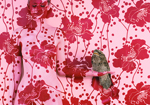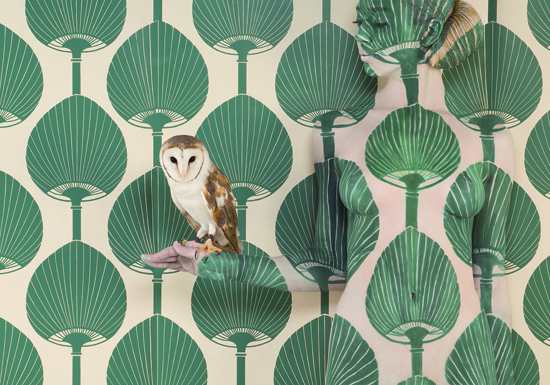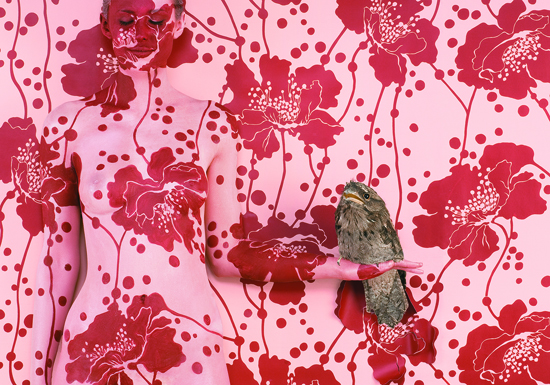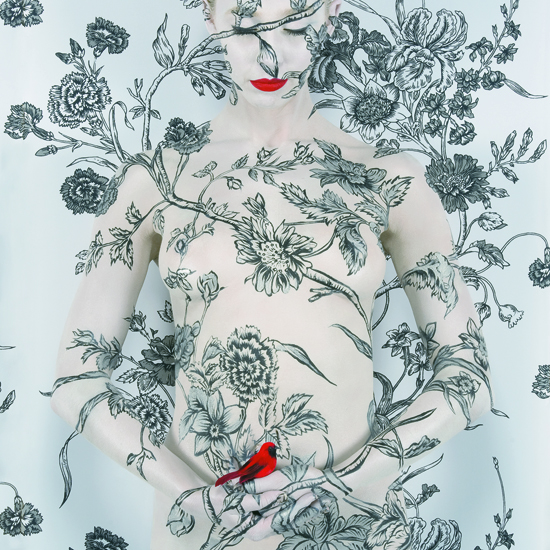 Text: Lisa Louden
Text: Lisa Louden
If you haven’t seen body art before, in Australia our shining exponent of the craft is Emma Hack. This talented artist takes her body art to new and unique dimensions through her choice of medium, and her latest exhibition featuring native Australian animals is no exception. Distinctive, captivating and beautiful, Emma’s art is raising eyebrows, issues and money.
Body Art 08 was inspired by the wallpaper designs of the late Florence Broadhurst. Broadhurst is a muse Emma’s used before; both Emma’s use of the medium and its creative application sets her work apart from her peers. This time, however, a Broadhurst wallpaper design inspired her creativeness in an unusual way. It was also the first time Emma has photographed her own work for exhibitions.
‘I was looking through the archive [of Broadhurst’s work] and saw the crocodile print and I knew then I wanted to use this and have a real crocodile in it. And let me tell you, it wasn’t easy to find.’
Eventually, after months of searching, she found Remabi Park in South Australia, an education facility designed to teach people of all ages about Australian wildlife. Animals from the park are used to being handled, and considering some of the animals are painted – using water-based body paint, safe for skin and fur – the exhibition couldn’t have been created using ‘regular’ wildlife. Interestingly, Emma says the animals seemed to enjoy the attention.
‘The lizard [water dragon] just sat there and watched me paint it and really seemed to enjoy it,’ she says. ‘It was fascinating seeing it watching me so intently, like it was really interested in what I was doing.’
Some animals were more challenging to paint than others. ‘I don’t know who said that turtles were slow,’ says Emma, ‘It’s not true! They were so quick.’

Emma has always loved animals and in particular is drawn to birds. ‘I fell in love with the owl in the shoot,’ she says, who responded to the intermittent beeping of her cameras in between shots with a curious turn of its head from camera to camera. ‘He was so aware of everything.’
With wildlife carers in tow to ensure safety and appropriate handling, the animals’ needs always came first. Despite the adage that you should never work with children or animals, Emma says the whole process was calming and enjoyable. ‘It was such a lovely vibe working with all of them. Hanging out with animals is such a wonderful way to work.’
It’s not the first time Emma has featured animals in her work. Inspired by the travelling fibreglass cow exhibition Cow Parade, she wondered what it would be like to use real cows in an exhibition. The end result was Cowscape, her first exhibition featuring animals, which raised funds for the South Australian Farmers Federation to help relieve the current hardship faced by farmers due to drought. Similarly, the opening night of Body Art 08 raised funds for the Native Animal Network, and the exhibition is also designed to raise awareness of the plight of wildlife in their diminishing habitats.

During the painting sessions, Emma was aware of keeping calm and being respectful to the animal during the process. When she painted the cows, for instance, she always made sure they knew where she was by keeping her free hand on them while she painted.
Body art has a large following in Europe and the United States, but it’s not as well known in Australia. The portrait of a naked, painted and pregnant Demi Moore on the cover of Vanity Fair in 1991 catapulted it into the public eye. A make-up artist by trade, Emma has always had a love of art and started face painting while at school for pocket money. The painted faces from the musical Cats captivated and inspired her, and also made her realise she could make a career out of her passion. Now, her CV is crammed with interesting and varied designs for clients from both Australian and overseas.
Body art traditionally uses the nude human form, and when Emma first began, she says she felt ‘really uncomfortable’ painting nude bodies, despite the fact for her it’s never been about sexuality. ‘I don’t see what I do as sexual; it’s a sensual thing. It’s about not being nude or being exploited.’

Emma says she always asks her model what they feel uncomfortable about in relation to their bodies and tries to cover it. ‘It’s about feeling good, so if something doesn’t feel good to the model, it will come out in the shoot.’
Interestingly, the use of animals achieved what sometimes can’t be when using human subjects – it eliminated nudity. It also exposed Emma’s work to a new audience, and animal aficionados have responded to it in droves by buying her work.
‘Anyone who buys an image and wants to put it on their wall, that is the biggest compliment I can receive,’ says Emma. ‘It means they enjoy my work enough to look at it every day.’
Body painting can take anything from three to six hours depending on the complexity of the design, so models need stamina. One case in point was an intricate Broadhurst design that took a staggering 21 hours to complete. The crocodile image Evolution was also time-consuming, but well worth the effort.
‘I cried when I finished that piece because I loved it so much,’ says Emma. ‘It was exactly what I wanted to create.’

For more of Emma’s work or to book a commission go to www.emmahack.com.au

